Vivint Touch Screen: Features and Integration Insights
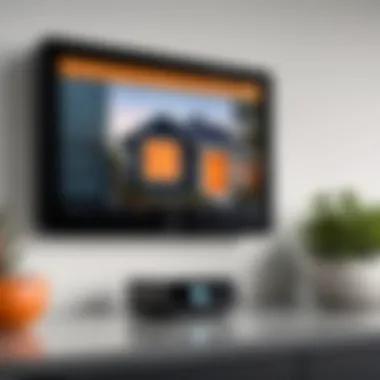

Intro
The Vivint touch screen represents a significant advancement in home automation technology. As a central control hub, it facilitates various interactions between users and smart devices within a residential setting. By integrating security, lighting, and temperature control into one interface, it aims to streamline home management and enhance user experience. This article will explore the features, functionality, and integration capabilities of the Vivint touch screen, providing valuable insights for IT professionals and tech enthusiasts alike.
Features Overview
Key Specifications
The Vivint touch screen is equipped with several key specifications that define its performance and usability:
- Screen Size: The device features a 7-inch display, providing ample space for interactions and visibility.
- Resolution: With a resolution of 1024 x 600, images and icons are sharp and clear, improving user experience.
- User Interface: The interface is designed for intuitive navigation, featuring touch-sensitive capabilities that respond quickly to user inputs.
- Wireless Connectivity: The touch screen supports Wi-Fi and Z-Wave, enabling effective communication with other smart devices.
Unique Selling Points
Several distinct features set the Vivint touch screen apart from its competitors:
- Integrated Security System: It acts as a command center for Vivint’s security offerings, allowing users to view camera feeds and manage security settings.
- Smart Home Integration: The touch screen easily integrates with other Vivint products, facilitating a cohesive smart home experience.
- Customizable Scenes: Users can create personalized settings for different scenarios, such as ‘Away’ or ‘Night,’ adjusting various aspects of the home environment with one touch.
- Real-Time Notifications: It provides important alerts and notifications, ensuring users stay informed about their home's status.
Performance Analysis
Benchmarking Results
Performance metrics for the Vivint touch screen indicate its robustness in handling day-to-day tasks:
- The system reacts within 2 seconds for typical commands, indicating low latency.
- It can support connections with up to 50 smart devices without performance degradation.
Real-world Scenarios
In practical applications, users have noted the following experiences:
- Many homeowners appreciate the quick access to security camera feeds, which can be conveniently viewed through the touch screen.
- Users report satisfaction with the seamless control of temperature and lighting, allowing for energy-efficient management of their household.
"The Vivint touch screen has profoundly changed how we manage our home, making everything much simpler and more efficient."
Intro to Vivint Touch Screen Technology
The Vivint touch screen serves as a pivotal element in the ecosystem of smart home technology. Understanding its role is essential for any informed decision-making regarding modern home automation systems. The touch screen not only acts as a control hub but also enhances user interaction with various devices within a home. This introduction will delve into the definition and purpose of the Vivint touch screen while also considering its target audience.
Definition and Purpose
The Vivint touch screen is a multifunctional device designed to centralize control of smart home systems. Its primary function is to provide users with an intuitive interface that integrates security features, home environment controls, and various smart devices. The touch screen enables users to easily manage their home's security, temperature, lights, and appliances from one location. Additionally, it enhances the overall user experience by combining several home automation functions into a single, accessible device, streamlining interactions in the modern smart home.
The purpose of this technology extends beyond mere convenience. It aims to empower users by providing them with greater control over their home environments. This device represents a shift toward a more automated and responsive living experience, allowing users to customize features according to their specific needs. With features such as remote access, real-time notifications, and comprehensive monitoring capabilities, the Vivint touch screen fosters a proactive approach to home management.
Target Market and Users
The Vivint touch screen is targeted primarily at tech-savvy homeowners seeking to enhance their living spaces through smart technology. The user demographic includes IT professionals, home automation enthusiasts, and individuals invested in improving their home's security and efficiency. This target market is diverse and spans various age groups, often characterized by a willingness to embrace new technology.
Moreover, users appreciate the importance of integration and seamless functionality in their devices. Those who prioritize home security, energy management, or remote accessibility are likely to find the Vivint touch screen particularly beneficial. As home automation systems continue to evolve, the demand for such centralized control solutions grows, affirming the relevance of the Vivint touch screen in today’s tech landscape.
"In the age of smart homes, the Vivint touch screen plays a central role in user control, making it a quintessential tool for modern living."
By examining the features and functionality of the Vivint touch screen, this article aims to further elaborate on its significance and suitability for various users.
Core Features of the Vivint Touch Screen
The Vivint Touch Screen serves as an essential hub for smart home control, showcasing a variety of core features that enhance its functionality and usability. Understanding these features is crucial for users who want to maximize their experience and efficiency in managing home automation. The Touch Screen not only integrates control of various smart devices but also provides a seamless interface that users can navigate easily. This section explores the key attributes that make the Vivint Touch Screen stand out in a competitive market.
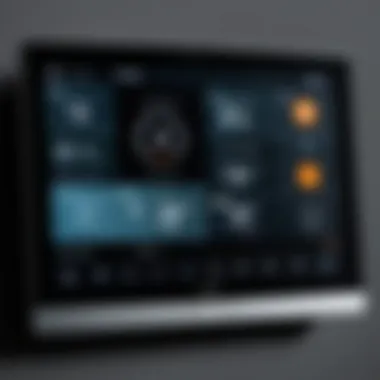

User Interface Design
The user interface design of the Vivint Touch Screen is pivotal for user interaction. A clean, intuitive layout allows users to navigate with ease. The buttons and icons are well-defined, leading to efficient user engagement without overwhelming the user. Users can quickly access various functionalities, such as home security settings, climate control, and media function management. Additionally, the design incorporates visual cues that guide the user throughout the system, making it simple for even non-technical users to operate effectively.
Moreover, the color scheme is pleasant and harmonizes with most home decor styles. It reduces eye strain, allowing users to interact for longer periods without discomfort. The responsiveness of the touch screen further enhances the experience. Users can expect rapid feedback from their actions, which encourages consistent engagement with the device.
Touch Sensitivity and Responsiveness
Touch sensitivity and responsiveness are fundamental when it comes to user satisfaction. The Vivint Touch Screen boasts a highly responsive touch interface. It registers even the lightest touch swiftly, minimizing the delay between user intention and action. This speed is essential for users who rely on the device for critical tasks, such as arming the security system or adjusting home temperature settings.
In practice, the effective touch sensitivity allows for fluid interactions. Users can swipe, pinch, and tap without experiencing frustrating lag, making the experience more enjoyable. Accurate responsiveness contributes directly to the overall efficiency of the system. It ensures that users are less likely to make mistakes during operation, which can be particularly important in high-stakes situations involving security controls.
Customization Options
Customization options enhance the user experience by allowing individuals to tailor the device to their preferences. The Vivint Touch Screen offers a range of settings that users can modify, promoting a sense of ownership and personalization. Users can adjust visual settings, rearrange icons, and even choose what information appears on the main screen.
This flexibility means that each user can create an environment that suits their workflow. For example, users can prioritize security systems over other functions if that is their primary concern. Furthermore, customized alerts and notifications can be configured, ensuring that users receive information that matters most to them, thus improving the overall efficiency of home management tasks.
In summary, the core features of the Vivint Touch Screen not only facilitate control over home automation but also enhance user experience through well-designed interfaces, responsive touch technology, and extensive customization options. These elements ensure that users can interact with their smart home systems effectively, making it a pivotal element in modern home technology.
Integration with Home Automation Systems
The integration of the Vivint Touch Screen with home automation systems is pivotal in creating a seamless smart home experience. As households increasingly seek more control and connectivity among devices, understanding how the Vivint Touch Screen serves this role becomes crucial.
Compatibility with Smart Devices
The Vivint Touch Screen showcases impressive compatibility with various smart devices. It can connect to smart lights, thermostats, and security systems, offering a centralized control point. This means users can manage multiple aspects of their home environment from a single interface. Compatibility extends not just to Vivint's own products but also to many third-party devices. This flexibility increases the appeal of Vivint's technology, allowing users to customize their systems according to their specific preferences or existing setups.
Centralized Control Functions
Centralized control is a defining feature of the Vivint Touch Screen. This functionality allows different smart devices to work together under one unified platform. For instance, a user can set an automation that activates the home’s security alarms while lowering the smart thermostat simultaneously. Such benefits enhance user convenience and provide efficiency for daily routines. Furthermore, the interface displays the status of connected devices and settings, leading to informed management and control.
Remote Accessibility Features
The ability to control devices remotely is another compelling aspect of the Vivint Touch Screen's integration with home automation systems. Users can access their smart home devices through the Vivint app available on smartphones, which is crucial when not at home. This functionality enables real-time monitoring and control over lighting, temperature, and security systems. Additionally, users can receive alerts and notifications, ensuring they are always informed about their home’s status, regardless of their location.
"The integration of multiple systems creates an ecosystem that simplifies user experience, making it easier to manage modern smart devices efficiently."
In summary, the Vivint Touch Screen’s integration with home automation systems significantly enhances user experience, providing compatibility, centralized control, and remote management capabilities. Such features align well with the needs of tech-savvy homeowners and contribute to a genuinely connected living space.
Installation and Setup Process
The installation and setup process of the Vivint Touch Screen is a critical component that affects the overall performance and user experience of the system. A well-executed installation not only ensures that the device functions optimally but also enhances the security and automation capabilities of a smart home. It is essential to approach this phase with careful consideration, as improper installation may lead to connectivity issues or malfunction of features. Therefore, understanding the preparation steps, following a detailed guide, and recognizing potential challenges can streamline the installation.
Preparation Steps
Before diving into installation, some preliminary steps are advised to create a smooth experience. First, verify the location where the Vivint Touch Screen will be installed. It should be a spot with adequate access to power and internet connectivity. Also, consider the visibility and usability of the screen from various areas within the house. Next, gather all needed tools. A screwdriver, level, and possibly a drill may be necessary. This preparation reduces interruptions during the actual setup. Additionally, ensure that all components of the system, including sensors and cameras, are ready for integration.
Step-by-Step Installation Guide
Following the preparation, execute the installation using these structured steps:
- Mounting the Device: Start by placing the Vivint Touch Screen against the selected wall. Use a level to ensure it is straight. Mark the positions for pilot holes if needed.
- Drilling Holes: Drill small holes for anchors if the surface requires it. This step is vital for securely fastening the device to the wall.
- Connecting Power Supply: Plug the touch screen into the nearest power outlet. Ensure the cord is neatly managed to prevent visible clutter.
- Network Configuration: Follow the instructions to connect the device to the home network. Enter the necessary Wi-Fi credentials as prompted on the screen.
- Device Pairing: Once the network setup is complete, start pairing the touch screen with other Vivint devices, this includes alarms and cameras.
- Software Updates: Finally, check for any available updates for the device software to ensure it has the latest features and security patches.
Common Installation Challenges
While installing the Vivint Touch Screen, various challenges may arise. One common issue is connectivity problems, often caused by poor Wi-Fi strength. It is crucial to test the signal quality at the installation site before proceeding. Another frequent concern is aligning the screen correctly. If not positioned accurately, it might affect usability.
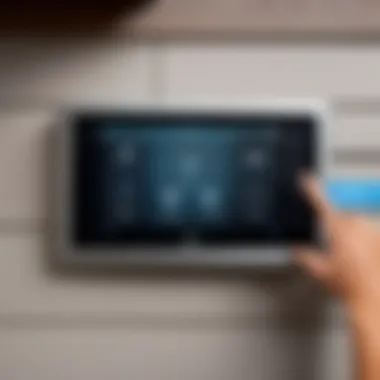
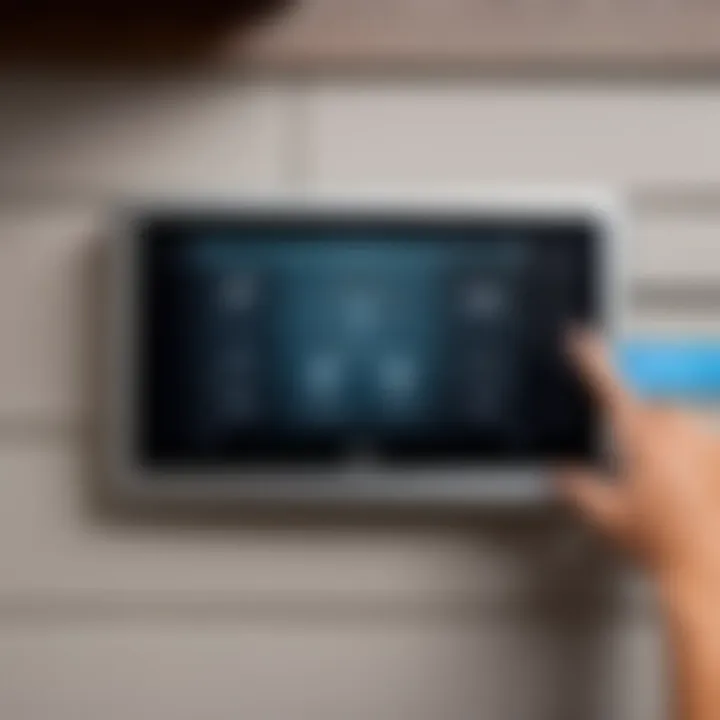
Furthermore, a lack of preparation may lead to not having all necessary tools or equipment ready, which can prolong the setup process. Troubleshooting these issues requires patience and sometimes revisiting the preparation steps to ensure everything needed for installation is on hand.
Installing the Vivint Touch Screen correctly impacts all connected smart devices in the home, optimizing the entire system’s functionality.
By paying attention to installation details, users can maximize the performance of the Vivint Touch Screen and ensure reliable integration within their home automation environment.
Vivint Security Features
Vivint’s security features play a crucial role in its overall appeal. As smart homes become more prevalent, having an efficient and reliable security system becomes paramount. Vivint integrates various security functionalities into the touch screen device, serving as a hub for managing home safety. This aspect not only provides peace of mind but also encourages users to embrace smart home technology fully. Those in the IT and tech fields appreciate how these functions combine technology with practical security needs.
Alarm System Integration
Alarm system integration is a pivotal component of Vivint’s security features. The touch screen works seamlessly with Vivint’s alarm systems, allowing users to arm or disarm security protocols directly from the interface. Users can select various modes such as 'Away', 'Home', and 'Disarm'. Each option adjusts the security settings accordingly, prioritizing different levels of protection and convenience based on user activity. Having this feature enhances user control and facilitates quick responses to alerts.
Furthermore, the system includes real-time notifications if the alarm is triggered, which alerts users immediately. This level of accessibility ensures that home safety is always a priority.
Monitoring Capabilities
Vivint also offers comprehensive monitoring capabilities as part of its security features. The touch screen can connect with both indoor and outdoor security cameras. Users receive live video feeds directly on the screen, ensuring they stay informed about their property’s status at all times. The integration allows for customizable settings, where users can choose which cameras they want to monitor depending on their needs.
Moreover, the system can distinguish between routine events and potential security threats. It analyzes movements and triggers alerts, helping avoid unnecessary notifications for minor incidents. This capability not only aids in comprehensive monitoring but also in reducing user anxiety.
User Notification Systems
User notification systems are essential for maintaining a heightened security environment. Vivint ensures that users are kept informed through various channels—whether it's through the touch screen, mobile app, or automated phone alerts. The system updates users about any alarm trips, unusual motions detected, or system malfunctions.
"Real-time notifications represent a vital aspect of proactive security management."
Users can set preferences for alerts, deciding how they would like to be notified. This flexibility fosters an intuitive experience while allowing users to remain as engaged or disengaged as they prefer. With various notification methods, users are always connected to their security status, enabling more informed decisions in real-time.
User Experiences and Feedback
User experiences and feedback are vital components in evaluating the effectiveness of the Vivint Touch Screen. They provide real-world insights beyond technical specifications, revealing how users engage with the technology on a daily basis. Understanding both positive and negative feedback allows potential buyers to make informed decisions, ensuring they select a product that meets their needs and expectations.
Positive Aspects Highlighted by Users
Users of the Vivint Touch Screen often emphasize its intuitive interface and ease of use. Many appreciate the visually appealing design and the clarity of the display, making it easy to navigate through various controls. The touch sensitivity is generally praised, with users noting that it responds quickly and accurately to inputs. Convenience is a recurring theme; users enjoy being able to access all their smart home devices from a centralized location without having to switch between multiple apps or gizmos.
Another aspect frequently highlighted is the integration capabilities with other smart devices. Users find that connecting other devices, such as thermostats and cameras, enhances their smart home experience significantly. The ability to control multiple systems from the Vivint Touch Screen has been described as a game-changer for home automation. Furthermore, users report satisfaction with the remote accessibility features, which allows them to monitor and control their homes while away.
Criticisms and Limitations
Despite numerous positive reviews, several criticisms of the Vivint Touch Screen have emerged. One common issue reported is the occasional lag in responsiveness, particularly when used with multiple systems linked together. This can lead to user frustration, especially when quick responses are required.
Some users have expressed dissatisfaction with the installation process. While many find it manageable, others feel that clearer guidelines or better instructional materials would be helpful. The learning curve associated with certain features can also serve as a barrier for those less tech-savvy.
Additionally, privacy concerns have been raised regarding data security. Users want to ensure their personal information and home settings are protected from potential cyber threats. This concern can overshadow the positive aspects, leading to hesitation among prospective users.
In summary, while the Vivint Touch Screen receives commendations for its design and functionality, challenges remain that affect the user experience. Engaging with both positive and negative feedback equips potential users with a balanced view of the product's performance in real-life settings.
Performance Evaluation
Performance evaluation is a crucial aspect to consider when analyzing the Vivint Touch Screen. Understanding how well the device operates under different circumstances can provide great insight into its value and overall effectiveness in smart home systems. This evaluation encompasses various components such as speed, efficiency, and reliability. Each of these factors contributes to the user experience, determining whether the touch screen is able to meet or exceed expectations in real-life applications.
Speed and Efficiency
Speed is among the primary parameters that influence user satisfaction. A touch screen that responds promptly to user inputs can make controlling home automation systems effortless. If a device lags or fails to register commands quickly, it can lead to frustration and decreased usability.
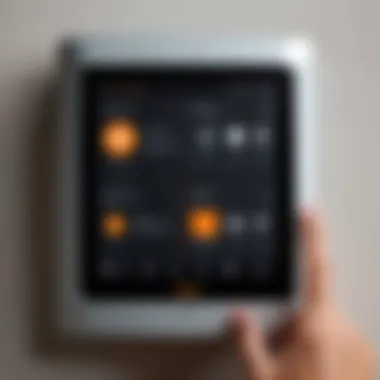
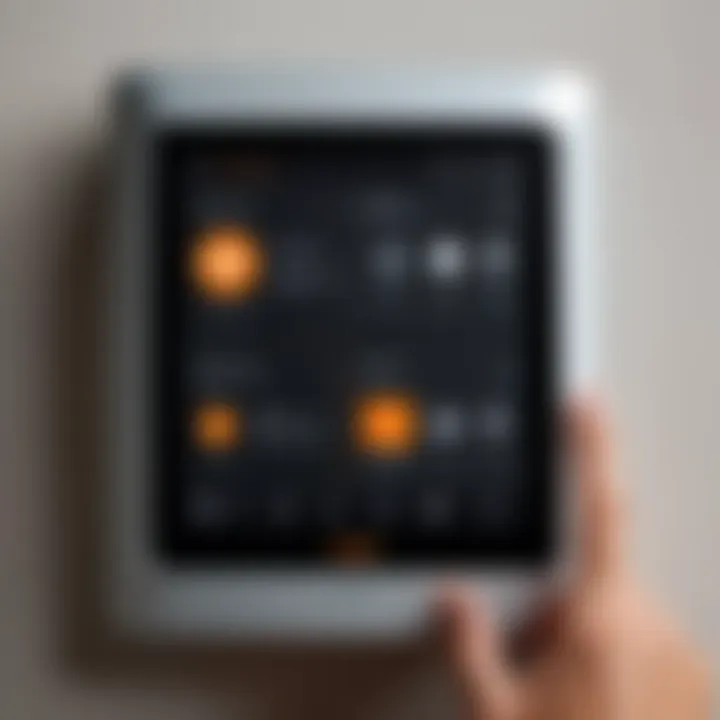
Efficiency refers to how well the Vivint Touch Screen manages resources and performs tasks within a minimal timeframe. It encompasses several points:
- Quick Load Times: Users expect their interface to load without delay. Delays in loading screens can impede the usability of the device.
- Fast Response Rates: When tapping on icons or buttons, the screen should respond instantly. Any noticeable lag could disrupt the flow of operations.
- Optimization for Multi-Tasking: The capacity to handle multiple command inputs simultaneously without a decrease in performance is vital. Users often navigate through various features at once, and a capable system can facilitate this effortlessly.
In summary, speed and efficiency significantly influence how users perceive the Vivint Touch Screen. Ensuring that both are optimized helps maintain a seamless and productive experience.
Reliability in Various Conditions
Reliability refers to the ability of the Vivint Touch Screen to function consistently and predictably across different environments. This aspect is particularly important in smart home technology, where users may encounter diverse scenarios. A reliable device offers several advantages:
- Consistent Performance in Varying Conditions: The touch screen should maintain its performance whether users are in different rooms, using it in low-light conditions, or during fluctuations in home network stability.
- Durability against External Factors: As a home automation hub, the device may be exposed to different temperatures and humidity levels. Assessing its performance under these factors can indicate its long-term viability and customer satisfaction.
- Error Management: A reliable system will also incorporate features that mitigate errors, ensuring that users can still perform essential functions even when issues arise.
Comparative Analysis with Competitors
Examining the Vivint Touch Screen in the context of its competitors is crucial for understanding its strengths and limitations. This comparative analysis gives insights into how the Vivint Touch Screen stands out and where it might fall short against alternative products. A well-rounded understanding of the landscape can guide consumers in making informed choices regarding smart home technology.
Similar Products Overview
In the growing market of smart home control panels, several comparable products are available. Devices like the Google Nest Hub, the Amazon Echo Show, and the Samsung SmartThings Hub compete for attention. Each of these products offers unique features and functionalities tailored to various user preferences and needs.
For instance, the Google Nest Hub emphasizes voice control and integration with Google services. The Amazon Echo Show enhances video calls and contains Alexa, offering robust voice command capabilities. Samsung's SmartThings Hub presents a broad compatibility list that covers numerous smart device brands. These alternatives showcase a range from advanced voice interaction to extensive ecosystem compatibility, which are essential considerations for potential users.
Feature Differentiation
Differentiation of features is where a thorough evaluation is vital. While many competitors prioritize voice interaction, the Vivint Touch Screen focuses on a sleek, touch-based interface that appeals to users who prefer tactile engagement. Its display supports direct control of various smart devices, security systems, and energy management tools, making it inherently practical for real-time interactions.
Moreover, the Vivint Touch Screen excels in home security integration. Features like real-time monitoring and remote access to cameras provide a unique selling point that some competitors lack. It delivers centralized control of the entire Vivint ecosystem, allowing unified management of multiple devices through a single interface. Therefore, customers who prioritize security will find the Vivint Touch Screen advantageous.
Market Positioning
In terms of market positioning, the Vivint Touch Screen targets homeowners seeking a comprehensive smart home solution with an emphasis on security. Its strategic alignment with the broader Vivint home security brand builds trust, leveraging Vivint's established reputation in the market. The pricing of Vivint products positions them as premium options, aimed at tech-savvy consumers who view smart home technologies as essential rather than optional.
In comparison, some competitors like the Google Nest Hub may appeal to a broader audience with more versatile price points and functionalities. However, the Vivint ecosystem's designed integration serves loyal customers looking for seamless connectivity and enhanced security solutions.
In summary, the comparative analysis illuminates the Vivint Touch Screen's distinctive quality within a competitive landscape. By focusing on unique attributes such as security features and user interface, potential customers can weigh their options more effectively when deciding on smart home technology.
End and Recommendations
In discussing the Vivint Touch Screen, it becomes clear that it stands as a pivotal component of modern smart home technology. The conclusion drawn from this comprehensive overview emphasizes the value this device brings in terms of usability, security, and integration with various home automation systems. A well-rounded understanding of the features and functionalities allows users to make informed choices about their smart home setups.
Summary of Findings
The Vivint Touch Screen showcases numerous functionalities that cater to users' needs in a technologically advanced home environment. Key findings include:
- User Interface: Its user-friendly design is notable, facilitating easy navigation for users at all skill levels.
- Integration: The seamless compatibility with a range of smart devices enhances the overall smart home experience.
- Security Features: Integrated security options, such as alarm system connections and remote monitoring, provide users with peace of mind.
- Performance: Evaluations indicate a strong reliability record, performing well across different home conditions.
These insights collectively underscore the importance of the Vivint Touch Screen, especially for tech-savvy homeowners looking for efficient and secure smart home solutions.
Ideal User Scenarios
Several user scenarios stand out, showcasing ideal conditions for utilizing Vivint Touch Screen technology. These include:
- Tech Enthusiasts: Individuals who prioritize cutting-edge technology will likely appreciate its advanced features. The interface and customization options align well with their expectations.
- Families: Parents seeking to monitor home security will find the connectivity with alarm systems beneficial. The ease of use allows even children to engage with it in emergencies.
- Home Office Users: Professionals working from home can utilize the centralized control capability to manage smart devices efficiently, enhancing their work environment.
- Elderly Users: Its straightforward design makes it suitable for older adults who may find traditional technology challenging to navigate.
Identifying these user scenarios gives perspective on how varied audiences can benefit from the device’s functionality.
Future Considerations for Users
Users contemplating the Vivint Touch Screen should consider several factors before making a decision:
- Technological Advancements: Keeping abreast of upcoming updates or enhancements can affect the long-term utility of the device. Users may want to consider how easily the system adapts to new technologies.
- Integration with Future Devices: As the smart home market evolves, ensuring that the touch screen remains compatible with future devices and technologies will be essential.
- User Training: Even though the device aims at a user-friendly experience, occasional training sessions can help users maximize its potential.
- Cost vs. Benefits: Evaluating the overall investment against the security and convenience benefits is crucial. Users should assess their priorities in smart home functionalities.
By taking these future considerations into account, users can navigate their smart home journey effectively, ensuring that the Vivint Touch Screen serves them well in both the present and future.



